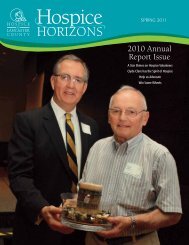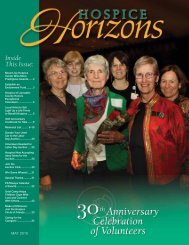You also want an ePaper? Increase the reach of your titles
YUMPU automatically turns print PDFs into web optimized ePapers that Google loves.
“ The quiet, calming atmosphere of the Inpatient Center<br />
moved me to the point that I knew the right w decision<br />
was made for my husband.”<br />
patient and family to establish a plan<br />
for managing symptoms, including<br />
pain, wound care, breathing problems<br />
and nausea. Certified hospice aides are<br />
available to assist with personal care,<br />
feeding and meal preparation.<br />
The Inpatient Center stay is short-term<br />
and patients may return home after<br />
symptoms are controlled. Inpatient<br />
Center nurses spend time helping<br />
family caregivers learn how to manage<br />
caring for their loved ones. Caregivers<br />
can learn how to give medications,<br />
help care for wounds and provide<br />
personal care.<br />
Linda Wolf, RN, Team Leader,<br />
Lancaster Inpatient Center says,<br />
“<strong>Hospice</strong> patients and families who<br />
are receiving care at home and are<br />
struggling with pain or other difficult<br />
symptoms should speak to a member<br />
of their Home <strong>Hospice</strong> Team. A shortterm<br />
stay at the Inpatient Center<br />
could provide a quick turnaround of<br />
distressing symptoms and the patient<br />
could then return home when the<br />
symptoms are more managed.”<br />
Social workers are key <strong>Hospice</strong><br />
Inpatient Center team members and<br />
are available every day to provide<br />
emotional support and assistance<br />
with care plans, accessing community<br />
resources and medical insurance<br />
questions and paperwork.<br />
The Inpatient chaplain is available<br />
to provide spiritual support and<br />
can coordinate spiritual needs with<br />
a family’s clergy. For many, the<br />
opportunity to share concerns and<br />
emotions, ask questions or just have<br />
a kind hand to squeeze is a comfort<br />
during a stressful time.<br />
Board-certified and licensed<br />
complementary therapists may also<br />
assist through the use of music therapy<br />
or massage therapy, helping to lessen<br />
anxiety, reduce pain and provide an<br />
enhanced sense of calm.<br />
<strong>Hospice</strong> volunteers play a significant<br />
role in the personalized care patients<br />
and families receive. From distributing<br />
Comfort Kits containing toiletries,<br />
snack bags and useful items for family<br />
members who spend long hours in the<br />
Inpatient Centers, to sharing books and<br />
just holding hands, the companionship<br />
of these volunteers provides an often<br />
much-needed respite for family<br />
caregivers.<br />
The advanced stage of a serious<br />
illness can be the most vulnerable and<br />
challenging time a family can face.<br />
<strong>Hospice</strong> & Community Care provides<br />
care and support not only for patients<br />
but for the family members who care<br />
for them and share their lives, no<br />
matter where they may call “home.”<br />
For more information on how<br />
<strong>Hospice</strong> & Community Care can<br />
support your loved one please call<br />
(717) 391-2421. To see more images<br />
of the <strong>Hospice</strong> Inpatient Centers<br />
visit www.hospicecommunity.org.<br />
Garden areas, wandering paths and private patient patios offer peace and cooling shade in the summer.<br />
3







